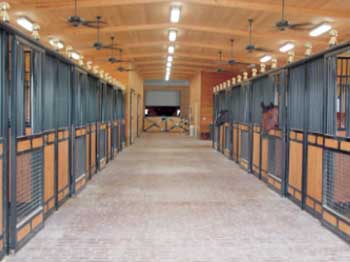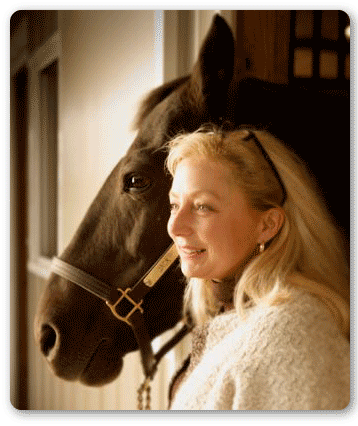Let There Be Light

The need for good quality light is never made more apparent than during winter's dark days. Aside from the obvious purpose of illuminating the barn and stalls, lighting has many other uses that you may not realize. Lighting in the stall and aisle way allows us to check on our horses inside their stalls. It shows us if the water bucket needs filled, if the stall needs cleaned and if supper is all cleaned up. Aside from the obvious, each of these things is also an indicator of our horse's overall well-being. Regular water consumption, food consumption and excrement indicate things are working properly.
However, if your horse isn't eating his grain, or is dropping it all over the stall, this could be a sign that his teeth need checked. Because of the way horses chew, small hooks can form on their teeth. If your horse isn't eating or is throwing his grain, he may need to have his teeth floated by an equine dentist. If your stall check reveals a pile of untouched hay and no recent droppings, your horse could be in serious trouble. Check for other signs of colic, such as frequent laying down and rising or nipping at the belly, and contact your vet.So, as long as your light fixtures shed enough light for you to check on your horses, their job is done, right? Wrong. Non-agricultural lighting and bare incandescent bulbs simply don't provide the quality of lighting needed to accurately assess a horse's condition. They can also be dangerous. Gum color, manure color and the color and brightness of eye whites are also things that indicate the overall health of a horse. While it may not seem difficult to assess any of these with the lights on, it is not guaranteed that the assessment will be accurate. Residential lighting can throw shadows and create strange colors in a barn, not exactly things that will help you when you're bent down examining that pile in the corner of your horse's stall.
Quality veterinary care can also be jeopardized by lighting that is not high-quality. Think of the difficulty your vet would have not only assessing your horse, but also stitching, drawing blood, giving a shot, checking a wound for infection or even taking your horse's temperature. Lighting that isn't meant for agricultural use, especially bare incandescent bulbs, can present several hazards for your horses. Barns are dusty places, filled with cobwebs and bits of hay. When these items accumulate on a bare incandescent bulb, the risk of fire is greatly elevated. Not only that, bare incandescent bulbs provide no protection from direct contact with the bulb. Even a cage around the bulb won't protect your horse if the bulb accidentally bursts or shatters.
So what kind of lighting is appropriate for a horse barn? Lighting that is specifically for agricultural use. RAMM carries these such type lights, which were not only designed specifically for agricultural use, but specifically for the equine industry. What makes these lights different? Their construction and performance. RAMM equine lights are UL approved and produce daylight quality light with better distribution. They are cool burning and come on instantly, even at temperatures as low as 20 below 0. The electronic ballast is designed to withstand power surges that can be common in farm facilities. The lights are gasketed and enclosed, which seals out moisture, dust and bugs. Color rendition is accurate, making it possible to properly assess a horse's condition. They are also efficient and will reduce your electric bill. The lamps last up to 40 times longer than regular incandescent bulbs, meaning you'll spend less time and money changing out bulbs. These lights are also safer and don't present the fire hazard that lights of the past did. You may even be eligible for reduced insurance premiums when you update your barn lighting with agricultural lights. Certain models contain no rusting parts and are even safe for wash racks.
So don't just light up your barn, light it well. With the joy, friendship and compassion our equine friends provide, it's important that we provide them with the best quality care. With proper lighting, we can assess their conditions accurately and create a safer environment. We can also enjoy some reduced costs, which is never a bad thing. If you'd like to update your barn's lighting, or if you're looking for lights for your new barn, contact us. Our representatives can talk to you about RAMM lighting and which lights will be best for your application.
 Debbie has over 45 years experience with horses and equine-related businesses. She has owned, trained, boarded horses and run stables at various times in her career. She is a certified fence installer, has given balanced riding lessons, and has shown horses in Western, Western Pleasure, Trail, English, Hunter/Jumper, Fox Hunting, Hunter Trials, Dressage and driving classes. Debbie has been involved in foaling, and just about every aspect of horse ownership possible, and she welcomes your questions and comments. If you are interested in using any articles by Debbie, please send her an email.
Debbie has over 45 years experience with horses and equine-related businesses. She has owned, trained, boarded horses and run stables at various times in her career. She is a certified fence installer, has given balanced riding lessons, and has shown horses in Western, Western Pleasure, Trail, English, Hunter/Jumper, Fox Hunting, Hunter Trials, Dressage and driving classes. Debbie has been involved in foaling, and just about every aspect of horse ownership possible, and she welcomes your questions and comments. If you are interested in using any articles by Debbie, please send her an email.
